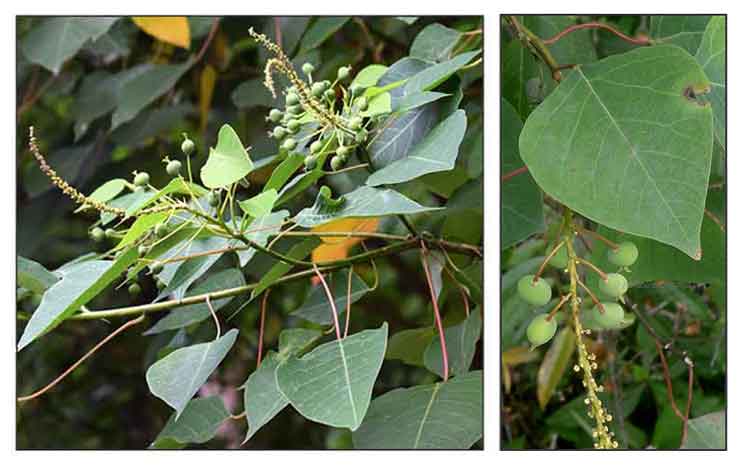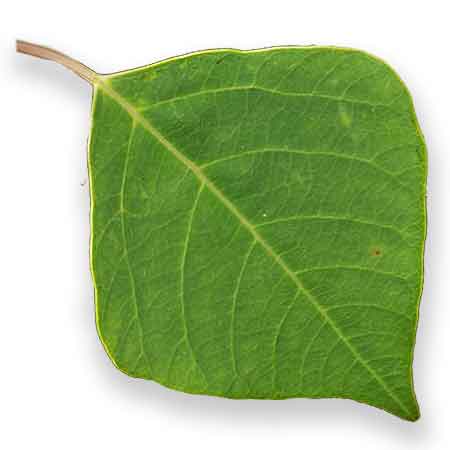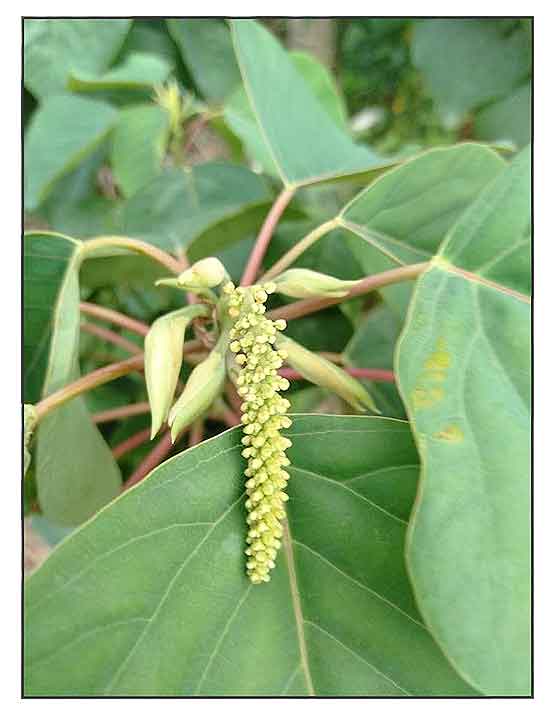
Family • Euphorbiaceae
Malabinunga
Balanti
Homalanthus populneus (Geiseler) Kuntze
MOUSE DEER'S POPLAR
| Scientific names | Common names |
| Carumbium populifolium Reinw. ex Blume | Balanti (Bikol) |
| Carumbium populneum (Geiseler) Müll.Arg. | Balante (S.Bis.) |
| Carumbium populneum var. minus Müll.Arg. | Malabinunga (Tagalog) |
| Exoecaria laevis Blanco | Mouse deer's poplar (Engl.) |
| Homalanthus leschenaultianus A.Juss. | Poplar-like bleeding heart (Engl.) |
| Homalanthus populneus (Geiseler) Kuntze | Populneus bleeding heart (Engl.) |
| Homalanthus populneus var. genuinus Pax | |
| Homalanthus populneus var. laevis (Blanco) Merr. | |
| Homalanthus populneus var. minor (Müll.Arg.) Merr. | |
| Homalanthus sulawesianus Airy Shaw | |
| Stillingia populnea Geiseler | |
| Homalanthus populneus is an accepted species. KEW: Plants of the World Online | |
| Other vernacular names |
| BORNEO: Bangki, Belantas, Belok malok, Bubalong, Bungalau, Buta-buta, Buta lalat, Butaq, Delamato, Gela, Kalang matoh, Kayu kelepela, Kelebutag, Kepelak, Ketapanng lalat, Laru, Ludai api, Majin, Merendang, Sedaman, Tapag lalat. |
| INDONESIA: Tutup, Tutup abang (Javanese), Totop (Madura), Kareumbi. |
| MALAYSIA: Ludahi, Kayu mata buta darat, Remaya. |
| THAILAND: Mae mae. |
April 2025
![]()
 |
| Â Â Â Â Â Â Â Â Â Â Â Â Â Â Â Â Â Â Â Â Â Â Â Â Â PHOTOS / ILLUSTRATIONS |
| IMAGE SOURCE: Homalanthus populneus / Twigs with inflorescences / Wibowo Djatmiko (Wie 146) / CC BY-SA 4.0 / Image modified / Click on image or link to go to source page / Wikipedia |
| OTHER IMAGE SOURCE: Euphorbiaceae : Homolanthus populneus / Leaf / Copyright © 2017 by P B Pelser & J F Barcelona (contact: pieter.pelser@canterbury.ac.nz) [ref. DOL118770] / Non-Commercial Use / Image modified / Click on image or link to go to source page / Phytoimages.siu.edu |
| OTHER IMAGE SOURCE: Homalanthus populneus / Noel Dionson - Pl@ntNet / CC BY-SA / Image modified / Click on image or link to go to source page / KnowYourWeeds |
| OTHER IMAGE SOURCE: Homalanthus populneus / © Yusran E Ritonga / Some rights reserved / NC BY-NC / Image modified / Click on image or link to go to source page / iNaturalist |
Additional
Sources and Suggested Readings |
• |
DOI: It is not uncommon for links on studies/sources to change. Copying and pasting the information on the search window or using the DOI (if available) will often redirect to the new link page. (Citing and Using a (DOI) Digital Object Identifier) |
| Â Â Â Â Â Â Â Â Â Â Â Â Â Â Â Â Â Â Â Â Â Â Â Â Â Â Â Â Â Â List of Understudied Philippine Medicinal Plants |
| Â Â Â Â Â Â Â Â Â Â Â Â Â Â Â Â Â Â Â Â Â New plant names needed The compilation now numbers over 1,500 medicinal plants. While I believe there are hundreds more that can be added to the collection, they are becoming more difficult to find. If you have a plant to suggest for inclusion, native or introduced, please email the info: scientific name (most helpful), local plant name (if known), any known folkloric medicinal use, and, if possible, a photo. Your help will be greatly appreciated. |
• |
 |




